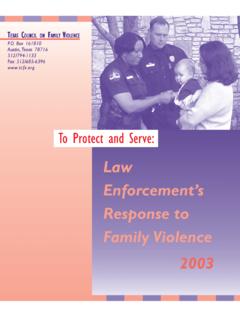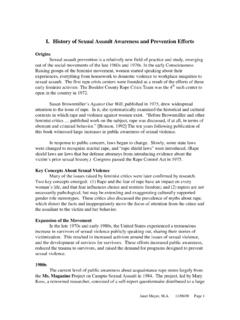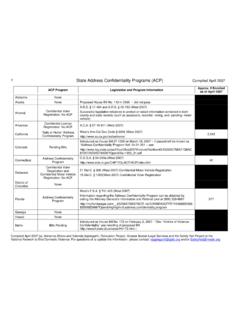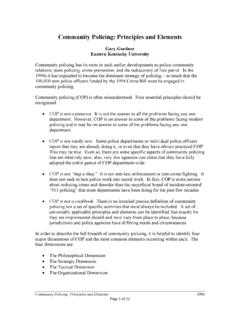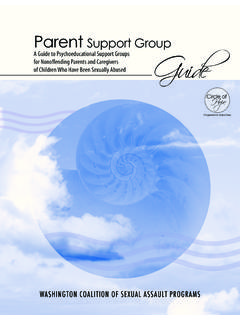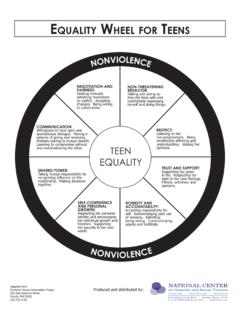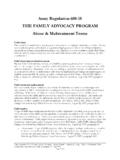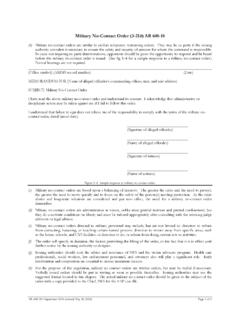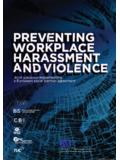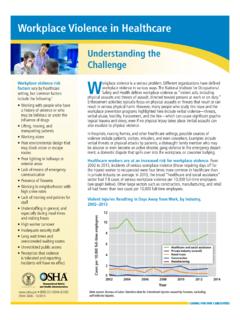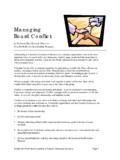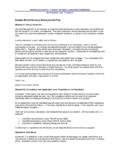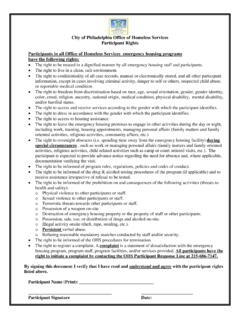Transcription of Table of Contents - National Center on Domestic …
1 [NAME OF COMPANY]. Sample Policy on Domestic Violence1. Table of Contents I. Date Issued p. 1. II. Purpose p. 1. III. Definitions p. 1-3. IV. Policy p. 3-6. V. General Guidelines Regarding Assistance for Survivors and Perpetrators p. 6-15. VI. Rationale p. 15. I. DATE ISSUED. The issue and effective date of this policy is _____. II. PURPOSE. [COMPANY NAME] is promoting the health and safety of our employees. Domestic violence is a leading cause of injury to women in this country. The purpose of this policy is to heighten awareness of Domestic violence and to provide guidance for employees and management to address the occurrence of Domestic violence and its effects in the workplace which will increase victim safety and offender accountability. III. DEFINITIONS. A. Domestic violence : A pattern of coercive behavior that is used by one person to gain power and control over another which may include physical violence , sexual assault and rape, emotional and psychological intimidation, verbal abuse, stalking, and economic control.
2 Domestic violence occurs between people of all racial, educational, religious, 1. This sample policy is based on materials from the following sources: Sarah M. Buel, , Tucker, Buel and Associates, General Policy: Incidents of Domestic violence and Sexual Assault Involving Employees, July 1, 1997;. James Hardeman, Guidelines for Providing Assistance in Managing Family violence Situations of Polaroid Corporation, 1995; It's Everybody's Business, March/April 1996, Volume 2, Issue 1, Corporate Alliance to End Partner violence ;. and Donna Norton, Esq., Stephen T. Moskey, , and Elizabeth Bernstein, The Workplace Responds to Domestic violence A Resource Guide for Employers, Unions and Advocates, The National Workplace Resource Center on Domestic violence , the Family violence Prevention Fund, January 1, 1998.
3 National Center on Domestic and Sexual violence Page 1 of 15. Sample Policy on Domestic violence 1998. economic backgrounds, in heterosexual and same sex relationships, living together or separately, married or unmarried, in short term or long term relationships. Domestic violence is a major cause of injury to women, although men also may be victims of such violence . Domestic violence and sexual assault are pervasive, serious crimes that not only affect individual victims and offenders, but they can also threaten workplace security, increase medical and insurance expenses, sick leave, absenteeism and employee turnover. B. Sexual Assault: Sexual penetration of anyone under age 17, or of an adult without consent, including one's spouse. This includes the actor compelling the other person to submit or participate by the use of physical force or violence or threatening to use force or violence against the other person, and the other person believes that the actor has the present ability to execute the threat.
4 [Texas Penal Code, Chapter 22, Section ]. C. Stalking: On more than one occasion, pursuant to the same scheme or course of conduct, directed specifically at another person, the actor knowingly engages in conduct including following the victim, that the actor knows or reasonably believes the other person will regard as threatening bodily injury or death to the person or the person's family or household, or threatening damage to the person's property, that causes the other person to fear one of the things listed above, and that would cause a reasonable person to fear one of the things listed above. [Texas Penal Code, Chapter 42, Section ]. D. Protective Order: A court order specifically designed to protect an individual who: is related to the offender by blood or marriage, currently lives in the same household or has ever lived in the same household as the offender, has a child with the offender, or is a foster parent with the offender.
5 Protective orders set out a list of items an offender can be ordered to do or refrain from doing. [Texas Family Code, Chapter 85, Sections and ] For example, if the offender and victim work for the same employer, the offender could be ordered to refrain from going to the floor of the building where the victim works. Protective orders can also address: child custody and visitation issues; the disposition of property mutually owned by the offender and victim; granting exclusive possession of the residence to a specific party; requiring child and spousal support; requiring the offender to successfully complete a batterer's intervention program; the disposition of community property; and prohibiting the offender from doing specified acts or requiring the offender to do specific acts to prevent family violence .
6 [Texas Family Code, Chapter 85, Sections and (a)]. E. Batterer, Perpetrator, Abuser or Offender: The individual who commits an act of Domestic violence as defined above. F. Batterer's Intervention Program: Programs batterers attend that are designed to eliminate violence in intimate relationships, stop other forms of abusive behavior and increase victim safety. Inappropriate batterers' intervention programs include, but are not limited to National Center on Domestic and Sexual violence Page 2 of 15. Sample Policy on Domestic violence 1998. couples, marriage, or family counseling and anger management courses. These have proven to be ineffective in stopping Domestic violence . G. Survivor or Victim: The individual who is the subject of an act of Domestic violence . IV. POLICY. A.
7 Early Intervention and Education Prevention Strategies 1. It is the policy of [COMPANY NAME] to use early prevention strategies in order to avoid or minimize the occurrence and effects of Domestic violence in the workplace. [COMPANY NAME] will provide available support and assistance to employees who are survivors of Domestic violence . This support may include: confidential means for coming forward for help, resource and referral information, additional security at the workplace, work schedule adjustment or leave necessary to obtain medical, counseling, or legal assistance, and workplace relocation. Written resource and referral information will be available in English and Spanish. Other appropriate assistance will be provided on individual need. In all responses to Domestic violence , [COMPANY NAME] will respect the confidentiality and autonomy of the adult survivor to direct her or his own life, to the fullest extent permitted by law.
8 2. [COMPANY NAME] will to maintain, publish, and post in locations of high visibility, such as bulletin boards and break rooms, health/first aid offices, company phone directories, and on-line information databases, a list of resources for survivors and perpetrators of Domestic violence , including but not limited to the National Domestic violence Hotline @ 800/799- SAFE or 800/787-3224 (TTY). The Employee Assistance Program and the Human Resources Department have a complete listing of local services that are available to victims and perpetrators of Domestic violence . 3. [COMPANY NAME] will ensure that all supervisors, managers and employees receive a copy of this policy, are aware of [COMPANY NAME]'s policies on these issues and, when possible participate in Domestic violence and sexual assault training.
9 4. [COMPANY NAME] will ensure that all supervisors, managers and employees are aware of possible warning signs of an abuse victim, such as unexplained bruises, change in attitude or performance, lack of concentration, increased or unexplained absences, depression or heightened anxiety, receipt of harassing telephone calls, and disruptive personal visits to the workplace. National Center on Domestic and Sexual violence Page 3 of 15. Sample Policy on Domestic violence 1998. 5. [COMPANY NAME] will ensure that all supervisors, managers and employees are trained in safety planning and the handling of emergencies, such as the offender showing up at the workplace, armed and threatening the victim and coworkers. 6. [COMPANY NAME] will ensure that all managers are trained to speak with an employee who appears to be in danger, following this policy and making appropriate referrals.
10 7. [COMPANY NAME] will, to the extent possible, offer employees a reasonable amount of time off during work hours to obtain a protective order, testify in the criminal trial, move or otherwise attend to emergency needs. 8. [COMPANY NAME] will ensure that any Company affiliated insurance companies do not discriminate against victims by denying or limiting coverage entirely or in part, based on health issue arising from the abuse. 9. [COMPANY NAME] will provide in-house legal assistance for victims of Domestic violence . 10. [COMPANY NAME] will provide a mailing address for employees who have safety concerns to use for state licensing purposes or professional information. B. Leave Options for Employees who are Experiencing Threats of violence 1. At times, an employee may need to be absent from work due to family violence , and the length of time should be determined by the individual's situation.

